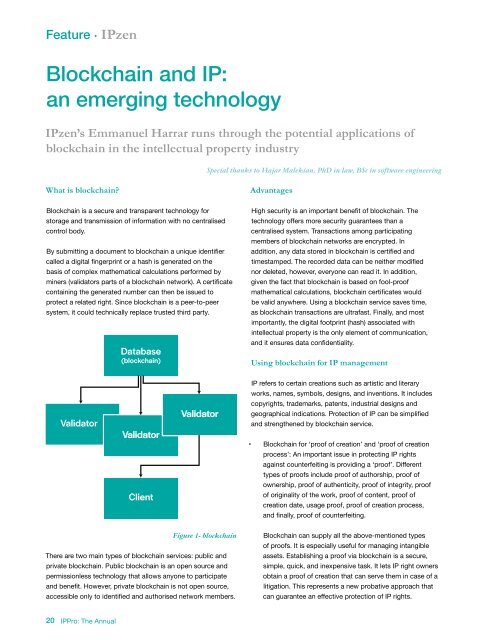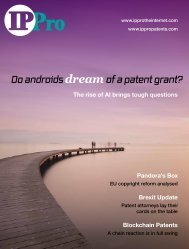IPPro The Annual 2018/19
The beating heart of the world is reaching new heights in innovation, with technology coming to the forefront in 2018 as an enabler of efficiency and automation. In the intellectual property industry, artificial intelligence, machine learning, and blockchain are beginning to shape the burgeoning technology services landscape, and exciting opportunities for both inventors and law firms alike are beginning to present themselves. However recent regulation, such as the EU’s General Data Protection Regulation has drawn a line in the sand for enforcers, resulting in far-reaching consequences across continents, and leaving brands open to attacks from those wanting to hide behind anonymity on the internet. All this, and more, is discussed inside IPPro: The Annual, which features comment and analysis from the world’s leading IP associations. We hope you like its new coat of paint and, as ever, if you have any feedback or suggestions, don’t hesitate to get in touch.
The beating heart of the world is reaching new heights in innovation, with technology coming to the forefront in 2018 as an enabler of efficiency and automation.
In the intellectual property industry, artificial intelligence, machine learning, and blockchain are beginning to shape the burgeoning technology services landscape, and exciting opportunities for both inventors and law firms alike are beginning to present themselves.
However recent regulation, such as the EU’s General Data Protection Regulation has drawn a line in the sand for enforcers, resulting in far-reaching consequences across continents, and leaving brands open to attacks from those wanting to hide behind anonymity on the internet.
All this, and more, is discussed inside IPPro: The Annual, which features comment and analysis from the world’s leading IP associations. We hope you like its new coat of paint and, as ever, if you have any feedback or suggestions, don’t hesitate to get in touch.
Create successful ePaper yourself
Turn your PDF publications into a flip-book with our unique Google optimized e-Paper software.
Feature · IPzen<br />
Blockchain and IP:<br />
an emerging technology<br />
IPzen’s Emmanuel Harrar runs through the potential applications of<br />
blockchain in the intellectual property industry<br />
Special thanks to Hajar Malekian, PhD in law, BSc in software engineering<br />
What is blockchain?<br />
Advantages<br />
Blockchain is a secure and transparent technology for<br />
storage and transmission of information with no centralised<br />
control body.<br />
By submitting a document to blockchain a unique identifier<br />
called a digital fingerprint or a hash is generated on the<br />
basis of complex mathematical calculations performed by<br />
miners (validators parts of a blockchain network). A certificate<br />
containing the generated number can then be issued to<br />
protect a related right. Since blockchain is a peer-to-peer<br />
system, it could technically replace trusted third party.<br />
High security is an important benefit of blockchain. <strong>The</strong><br />
technology offers more security guarantees than a<br />
centralised system. Transactions among participating<br />
members of blockchain networks are encrypted. In<br />
addition, any data stored in blockchain is certified and<br />
timestamped. <strong>The</strong> recorded data can be neither modified<br />
nor deleted, however, everyone can read it. In addition,<br />
given the fact that blockchain is based on fool-proof<br />
mathematical calculations, blockchain certificates would<br />
be valid anywhere. Using a blockchain service saves time,<br />
as blockchain transactions are ultrafast. Finally, and most<br />
importantly, the digital footprint (hash) associated with<br />
intellectual property is the only element of communication,<br />
and it ensures data confidentiality.<br />
Using blockchain for IP management<br />
IP refers to certain creations such as artistic and literary<br />
works, names, symbols, designs, and inventions. It includes<br />
copyrights, trademarks, patents, industrial designs and<br />
geographical indications. Protection of IP can be simplified<br />
and strengthened by blockchain service.<br />
••<br />
Blockchain for ‘proof of creation’ and ‘proof of creation<br />
process’: An important issue in protecting IP rights<br />
against counterfeiting is providing a ‘proof’. Different<br />
types of proofs include proof of authorship, proof of<br />
ownership, proof of authenticity, proof of integrity, proof<br />
of originality of the work, proof of content, proof of<br />
creation date, usage proof, proof of creation process,<br />
and finally, proof of counterfeiting.<br />
Figure 1- blockchain<br />
<strong>The</strong>re are two main types of blockchain services: public and<br />
private blockchain. Public blockchain is an open source and<br />
permissionless technology that allows anyone to participate<br />
and benefit. However, private blockchain is not open source,<br />
accessible only to identified and authorised network members.<br />
Blockchain can supply all the above-mentioned types<br />
of proofs. It is especially useful for managing intangible<br />
assets. Establishing a proof via blockchain is a secure,<br />
simple, quick, and inexpensive task. It lets IP right owners<br />
obtain a proof of creation that can serve them in case of a<br />
litigation. This represents a new probative approach that<br />
can guarantee an effective protection of IP rights.<br />
20 <strong>IPPro</strong>: <strong>The</strong> <strong>Annual</strong>





